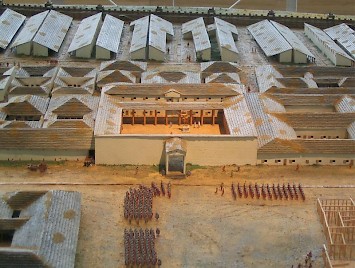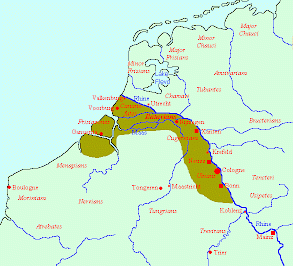Germania Inferior (3)
Q152136Germania inferior: small province of the Roman empire, situated along the Lower Rhine. Its capital was Cologne.
The legions

Germania Inferior and Germania Superior were created in the years 16-13 BCE as military zones in the Roman province Gallia Belgica. Officially, the commanders of the armies of the Lower Rhine and Middle Rhine were subordinate to the governor of Belgica, but in fact, they were autonomous. This situation was recognized by the emperor Domitian: in 83 or 84, he upgraded the military zones to independent provinces.
Until 16-13 BCE, the legions had been stationed as an occupation force on several places in the Gallic provinces. Now, they were transferred to the Rhine. The details are obscure, but it is certain that the following units were involved.
- In Germania Inferior along the Lower Rhine:
- In Germania Superior along the Middle Rhine:
- at Mainz: V Alaudae (?) and I Germanica.
- In the Gallic provinces: VIIII Hispana (??).

These units were supplemented with many auxiliary units, in which the natives could serve; in return, they received the Roman citizenship. Many auxiliary units are known to us, and it seems that especially the Batavians were a warlike tribe: they gave Rome no less than nine cohorts of infantry, one squadron of cavalry, and soldiers for the emperor's mounted bodyguard. (This means that every Batavian family had at least one son in the army.) Other tribes offered less soldiers (and therefore paid more taxes). There were two squadrons of Tungrian cavalry and four cohorts of infantry. The Morini, Menapians, and Frisiavones each offered one cohort; among the Ubians, three cohorts were recruited.
As we have already seen above, the Roman general Drusus used these units to attack the tribes on the east bank of the Rhine. New bases were built along the Lippe, first at Oberaden and later at Haltern. At the beginning of our era, the legions may have been stationed more or less like this:
- In Germania Inferior along the Lower Rhine:
- In Germania Superior along the Middle Rhine:
- at Mainz: V Alaudae and I Germanica.

However, the occupying forces were destroyed in the battle in the Teutoburg Forest (September 9 CE). Tiberius reorganized the armies: from now on, eight legions guarded the Rhine against the Germans.
- In Germania Inferior along the Lower Rhine:
- at Xanten V Alaudae and XXI Rapax;
- at Cologne I Germanica and XX Valeria Victrix.
- In Germania Superior along the Middle Rhine:
- at Mainz XIV Gemina and XVI Gallica;
- at Strasbourg II Augusta;
- at Windisch XIII Gemina.
In the next decades, the Roman forces of Germania Inferior continued to have a strength of four legions, although there were minor changes.
|
|
|
|
|
|
|
|
|
XVIII |
|
|||
|
|
XXI Rapax |
|
|
||
|
|
XXI Rapax |
|
|
||
|
|
XV Primigenia |
|
|
||
|
|
|
|
|
|
|
|
|
|
|
|
|
|
|
|
|
|
|||
|
|
|
|
|
||
|
|
|
|

The first of these was that Cologne was closed as a military base and became a civil settlement. Neuss and Bonn now became important garrisons (28?). After a decade, the emperor Caligula replaced XXI Rapax at Xanten with the newly recruited XV Primigenia, and a few years later, the emperor Claudius took away XX Valeria Victrix from Neuss, which was used during the invasion of Britain. It was replaced by XVI Gallica, which arrived from Germania Superior. This meant that the army of the Middle Rhine was weakened, but it seems that the German threat had diminished.
During the year of the four emperors (69), the army of Germania Inferior made a political mistake. It sided with the emperor Vitellius, who lost the civil war. Unfortunately, during this civil war, many soldiers of the Rhine army had to fight in Italy, and Germania Inferior was almost ungarrisoned. During the Batavian revolt (69-70), the remaining troops were no match to the rebels. The auxiliaries immediately sided with the Batavian leader Julius Civilis (after all, many auxiliaries belonged to the local tribes). V Alaudae and XV Primigenia were massacred during the destruction of Xanten, while I Germanica and XVI Gallica surrendered to another rebel, Julius Sabinus.
In 70, the new emperor Vespasian sent a capable general, Quintus Petillius Cerialis, to the north. He reorganized the two military zones along the Rhine. XXI Rapax replaced I Germanica at Bonn; VI Victrix, which defeated the Batavians, occupied the base of XVI Gallica, Neuss; Xanten was rebuilt and received XXII Primigenia; Nijmegen-Hunerberg was used again as a military base: here, X Gemina was to keep an eye on the Batavians.
From now on, the province became more quiet. In 83, the emperor Domitian campaigned on the east bank and conquered Baden-Württemberg, the country in the angle between the Rhine and the Danube. The frontier became considerably shorter, and the Romans started to remove troops. VI Victrix disappeared from Germania Inferior (c.95?); and XXI Rapax was replaced by I Minervia, a new legion. From now on, the two military zones were recognized as independent provinces. The border was at the Vinxtbach.

The only important change in the occupation force was that X Gemina was, after 100, replaced by VIIII Hispana. Perhaps the new soldiers were working on the fortifications along the Rhine, which were improved in these years (below).
At some point, VIIII Hispana was transferred to the east. From now on, only two legions were guarding the Lower Rhine frontier: I Minervia at Bonn, and VI Victrix at Xanten, which was later replaced by XXX Ulpia Victrix. They were to remain in Germania Inferior until the late fourth century, and became known as the exercitus Germaniae Inferioris, frequently abbreviated as EXGERINF.